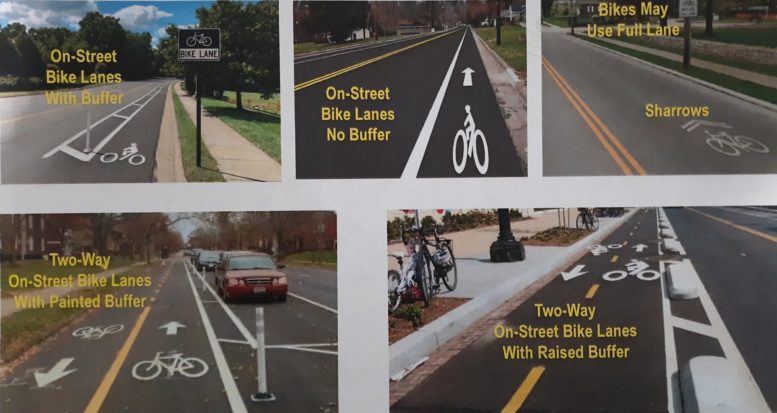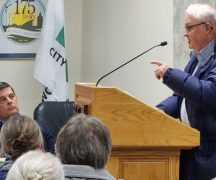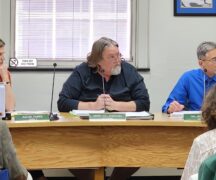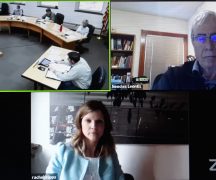By JAN LARSON McLAUGHLIN
BG Independent News
Road diets, a downtown bike bypass, and more use of pedestrian beacons could help motorists and bicyclists better share roadways in Bowling Green.
Infrastructure options for bicyclists are being examined in an updated bicycling study by Mannik & Smith in Bowling Green.
A road diet in Bowling Green could make bicyclists more comfortable riding on some city streets. Many city streets have 12-foot wide lanes, but ODOT allows 10-foot lanes – which leaves four lanes for a bike lane, said Pat Etchie, who presented the updated bike information to City Council Monday evening.
“When you’re reducing down to 10 feet, that makes drivers more aware of their surroundings and makes them slow down,” Etchie said.
The updated bicycling study in Bowling Green also discussed how a downtown bike detour could help keep cyclists off downtown sidewalks.

A map was presented, showing potential shared road corridors, future shared use paths, a downtown bicycle bypass route, existing shared use paths, existing sharrows, and the Slippery Elm Bike Trail.
City Council may codify a plan that will be used with future paving projects – so when a street is in line for repaving, it will already be determined if it should include bicycle treatments.
“It just depends as roads are being done, what’s feasible,” Etchie said.
City Council President Mark Hollenbaugh said the bike study will lead to future action on bicycling infrastructure in Bowling Green.
The information gathered by Mannik & Smith, showed the highest crash rates involving bicycles and motor vehicles are found on Main Street. The installation of pedestrian beacons on East Wooster Street has reduced car-bike crashes on that road, Etchie said.
“That’s the stuff that should be tried on Main Street in the future,” he said.
The bicycle facilities study looked at bike crashes in the city during the last five years, traffic volumes on roadways, an inventory of existing bike infrastructure, and results from a bike survey.
The bike study found that:
- Heaviest traffic of more than 8,000 vehicles per day is found on Main Street, Wooster Street and Poe Road.
- ODOT suggests that bicycle treatments on roads with average daily traffic of 8,000 or more, with speed limits of 35 or more, should have a separated bike lane or shared use paths.
- The majority of bicycle related crashes occurred on Main Street, with the majority of those crashes occurring at intersections. Speed contributed to many of those crashes.
A community bike survey conducted by grad students at BGSU listed the following findings:
- Most bicyclists (68%) feel safe and comfortable riding bikes in BG.
- If bicycling was made safer, 55% of respondents said they would bicycle more.
- Most residents (85%) said their preferred option to make bicycling safer on a busy road was bike lanes separated from traffic.
- 48% of respondents said they would support a tax levy to fund bike projects, while 31% disagreed. The remainder were neutral or unsure.
- The main reasons residents are riding their bikes are for exercise and fun.
- If riding to a specific place, most residents are riding to stores or restaurants.
- A quarter of respondents indicated they do not feel safe or comfortable riding bikes in BG. They indicated they would bicycle more often if they felt more safe or comfortable.
- Residents expressed mixed support for a biking infrastructure levy and lost parking.
- Residents are against their streets becoming one-way or losing part of their yard.
- The top three suggestions for making bicycling more safe and comfortable in BG are physically separated bike lanes, shared use paths, and on-street painted bike lanes.
- The survey respondents said they avoid Wooster and Main streets when riding bicycles.
“A lot of great information came out of this,” Etchie said.
Council member Joel O’Dorisio pointed out the level of support for bike infrastructure, saying “48% is pretty significant support.”
“It was stronger than I thought it would be,” Etchie said.
However, council member Bill Herald said those included in the survey may not have been representative of the community. And Hollenbaugh said surveys don’t always accurately reflect how people will vote.
Council member Nick Rubando expressed surprise that so many survey respondents feel comfortable bicycling on city streets.
“I consider myself a pretty good bicyclist,” yet he often feels unsafe on city streets, he said. “It seems dangerous to me.”
Etchie suggested that rather than proposing bicycle facilities along Main Street, that the city make intersection-related safety improvements to allow safer crossings of Main Street for bicyclists and pedestrians – similar to the beacon crosswalks installed on East Wooster during the past few years.
He also suggested that the city and BGSU explore widening the sidewalk along the northside of Wooster Street from Thurstin Avenue eastward to connect to the recently installed shared use path that starts on Alumni Drive and continues east over Interstate 75 to Dunbridge Road.





